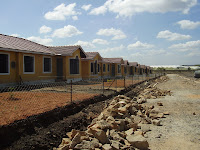Africa: The high return PPP Market of tomorrow.
 |
| A housing estate under construction: Many more of these are needed to meet growing demand |
The continent has fully emerged from the
painful yet beneficial structural adjustment programmes, SAPs, prescribed by
the IMF. SAPs implemented between the
mid-1980s and much of 1990s involved privatisation of State owned Enterprises,
SOEs among other structural reforms. Africa reluctantly adopted this prescription
but has emerged from it stronger, wiser, and prosperous.
SAPs had several positive lessons emerged
from privatization to wit; disposal of loss making SOEs plugged a hole in
government budgets resulting in lower donor dependency. Some of the privatized
SOES have turned the corner and are making profits and paying taxes and
dividends to the government. The private sector has proved that it is the
engine of economic growth creating wealth, jobs and affordable services.
The telecoms sector is a good example of
the benefits of privatization. Africa now boasts of more than 600 million
cellular phone handsets. The number is expected to hit 675 million by the end
of this year. This is a 67 per cent penetration rate in just about 20 years.
Landlines, which were in the public sector, had a penetration rate below 10 per
cent.
The industry has also proven quite adept at
innovations that serve Africa’s practical needs. Among these is the Mobile
money transfer developed in Kenya. M-Pesa as the service is called became an
informal banking service where one could deposit cash their phone accounts and
walk around with it rather than carrying cash. The mode is now used to pay
utility bills, pay for shopping and transfer funds. The hand set is now
business tool for the informal sector as artisans can be reached by their
clients on phone anytime.
And should one need cash, there are agents
allover including the rural areas, to pay cash. Started in 2007 by Safaricom,
East Africa’s largest cellular services provider M-Pesa has spread to other
networks and is the largest Cash transfer system in the country.
 |
| A wind farm: Brave investors are already on the ground |
The companies churn out large chunks of
profits and pay huge chunks in taxes. In fact upstarts, meaning companies that
are hardly 15 years old, have become giants in their areas.
In this category are such giants as Kenya
Airways and Safaricom. Kenya Airways is the third largest and the only
privatized airline in Africa. In fact it is a case study successful
privatization. Privatized in 1996, the airline has turned from the sick man of
Africa, to the pride of Africa. The airline is now gunning to be the largest airline
in Africa. See http://eaerb.blogspot.com/2012/02/kenya-airways-in-largest-rights-issue.html
Another benefit of
privatization is policy reforms. The private sector is now viewed as a serious
partner in Africa’s development by the governments. The capital markets have
gained from this paradigm shift. Now government securities such as long term
bonds are traded in the local securities exchanges.
Even innovative companies can borrow from
the local securities exchange using debt instruments such as long term bonds to
finance their expansion. Safaricom the local cellular operator was the first
company to break the glass ceiling. It was only two years old when it floated a
commercial paper, the largest in the market then, to finance its operations.
With a growing Middle class, growing
economies and growing demand for such infrastructure as housing, water and
sewerage system, roads, airports, sea ports, Railways lines and even new
cities, the stage is now set for the private sector to do more in Africa’s
development than in the past. See http://eaers.blogspot.com/2012/01/africa-next-big-investment-story.html
The leading economies in the continent are adopting Private-Public-Partnerships, PPPs, as a new development model.Already Nigeria, among the giant economies in Africa, has approved three bridges to be built on PPP basis. South Africa is already a front runner in this area while Kenya and Egypt are not too far behind.
Kenya has already slated a number of large
infrastructure projects for development on PPP basis. It has awarded a U S$640
million Airport terminal on a Design Finance Build and Operate basis. See http://eaers.blogspot.com/2012/02/authority-awards-640-m-contract-for.html.
Other projects in the pipeline using this development model is the Lamu-South
Sudan Ethiopia transport Corridor (LAPPSET). See http://eaers.blogspot.com/2012/02/kenya-to-begin-construction-of-gateway
, The
Konza ICT city, see http://eaers.blogspot.com/2012/02/kenya-rearing-to-launch-ict-city.html.
Robust studies show that, in US dollar terms, these projects have an IRR of
18-20 per cent
The trend in Africa is for the weak
economies to first let the stronger ones to employ certain models. Once the
weak economies see case studies in their neighbourhood, they pick-up. Now that
the larger economies have embraced PPP, the rest will soon follow suit.
This far, China, has stood slowed down
Africa’s adoption of PPPs as a development model. China, driven by its search
for raw materials, has built roads, railways, sea ports, hydro dams in Africa
as Public assets.
However, say analysts in Africa, demand
for infrastructure in Africa will soon exceed China’s ability to finance. This
will open the way for profitable participation in Africa’s development by the
Private sector. Already fund managers in the west have indicated that they will
take long-term positions in Africa, beginning this year. See http://eaerb.blogspot.com/2012/02/kenya-rated-second-best-investment.html.
Since China is also under pressure to reform its house, it will soon tighten
its purse strings. Bold investors, who have already read the writing on the wall are rushing to be on the ground building various
projects.
.




Comments
Post a Comment